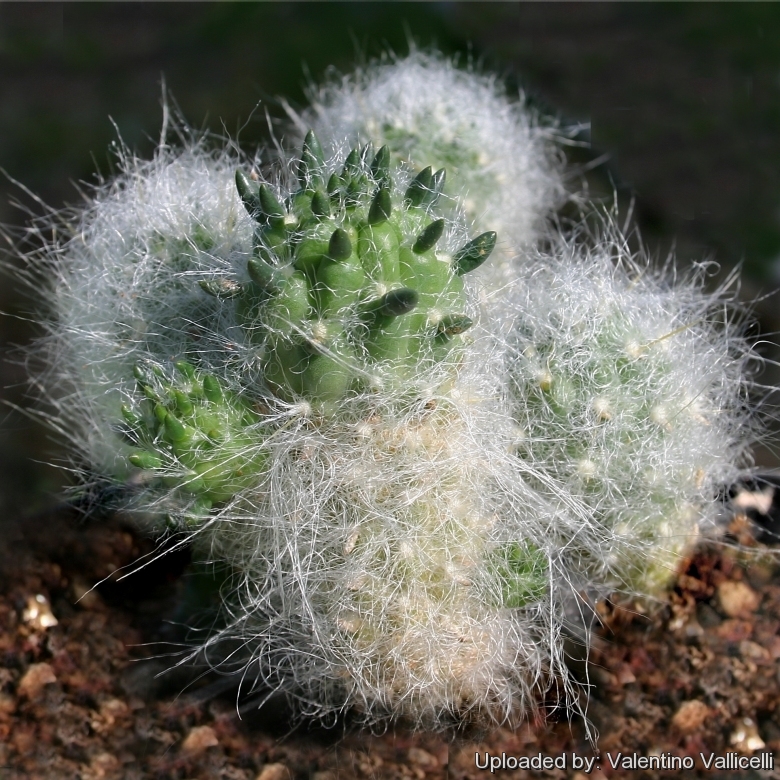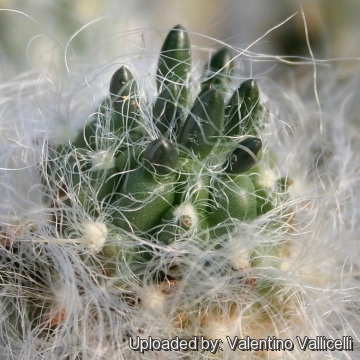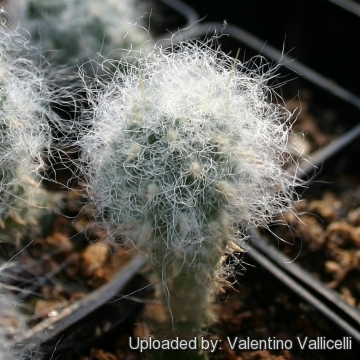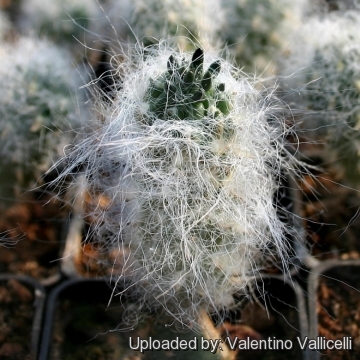= Austrocylindropuntia lagopus f. rauhii (Backeb.) F.Ritter
Kakteen Südamerika 4: 1243 (1981), without basionym vol. or page
Accepted Scientific Name: Austrocylindropuntia floccosa (Salm-Dyck) F.Ritter
Kakteen Südamerika 4: 1244 (1981)

Tephrocactus rauhii (Austrocylindropuntia lagopus f. rauhii) Photo by: Valentino Vallicelli
KK 393, Huancayo, Junin, Peru, Altitude: 4000m.
Origin and Habitat: This species is found widespread from central-Northern Peru to Bolivia in the Andean High Plateau.
Altitude: 3500-4700 m asl.
Habitat: This plant grows on the high puna region in dry valleys, rocky slopes among grasses and low bushes in high elevation tropical alpine habitats. Only here and there the brown colour of the grasses is interrupted by the white colour of the big cushions of the "wool cactus," Austrocylindropuntia floccosaSN|4105]]SN|4105]] (Tephrocactus floccosus). From the distance the plants look like recumbent sheep. The Puna region has a marked dry season and overnight temperatures that drop often below 0°C ( to -15° C ). The typical form of Austrocylindropuntia floccosaSN|4105]]SN|4105]] in central Peru has a dense covering of long hairs that protect from freezing temperatures and from high-altitude ultraviolet light, comparisons in habitat with 'hairless' forms showed that the hairy type maintain an epidermal temperature several degrees higher during the night. Austrocylindropuntia floccosaSN|4105]]SN|4105]] may be found in nature with its roots in snow-water-logged conditions.
More...Synonyms:
See all synonyms of Austrocylindropuntia floccosa
Common Names include:
ENGLISH: Polar Bear Cactus, Wool cactus, Living snow
GERMAN (Deutsch): Eisbärkaktus
SPANISH (Español): Huaraco
Description: Austrocylindropuntia lagopus f. rauhiiSN|4105]]SN|4113]] is one of the morphological or local forms of Austrocylindropuntia floccosaSN|4105]]SN|4105]], and the two plants are not readily distinguishable, if not for the geographical provenance. More likely they are one and the same species.
Habit: Austrocylindropuntia floccosaSN|4113]]SN|4105]] is a groundcover cactus that forms thousand-head colonies or compact cushions of up to 60 (and over) cm of diameter. This plant is covered with a dense, long-woolly felt of white hair and yellow spines from which emerge bright yellow flowers.
Segments: Short cylindrical, sometimes ellipsoidal to subglobose, up to15 cm long, 6 cm in diameter, spirally tuberculate.
Areoles: Borne high on tubercle shoulders.
Leaves: Rudimental, awl shaped, dark green, fairly persistent, to 7 mm long.
Glochids: Long, hairy, soft, sinuous, entangled or straight, sometimes absent and whitish/grey.
Spines: Occasionally 2 or more numerous yellow, erect approx. 2 cm long.
Flowers: Up to 3 cm long, petals orange-red (or yellow) with yellow centre; pericarpels
with areoles above, spineless.
Fruits: Truncate globose, sometimes with tubercles, yellowish when unripe, sugary/orange when ripen and slightly hairy.
More...Subspecies, varieties, forms and cultivars of plants belonging to the Austrocylindropuntia floccosa group
Bibliography: Major references and further lectures
1) David Hunt, Nigel Taylor “The New Cactus Lexicon” DH Books, 2006
2) Edward F. Anderson “The Cactus Family” Timber Press, 2001
3) James Cullen, Sabina G. Knees, H. Suzanne Cubey “The European Garden Flora Flowering Plants: A Manual for the Identification of Plants Cultivated in Europe, Both Out-of-Doors and Under Glass”Cambridge University Press, 11/Aug/2011
4) Curt Backeberg, Frederic Marcus Knuth: “Kaktus-ABC.” 1936
5) Curt Backeberg: "Die Cactaceae: Handbuch der Kakteenkunde." 2. Auflage. Band I, Gustav Fischer Verlag, Stuttgart New York 1982
6) N. L. Britton, J. N. Rose: “The Cactaceae. Descriptions and Illustrations of Plants of the Cactus Family.” Vol I, The Carnegie Institution of Washington, Washington 1919
7) Urs Eggli, Leonard E. Newton: “Etymological Dictionary of Succulent Plant Names.” Springer, Berlin/Heidelberg 2010
8) Curt Backeberg: “Die Cactaceae: Handbuch der Kakteenkunde.” 2. Auflage. Band I, Gustav Fischer Verlag, Stuttgart New York 1982
9) Friedrich Ritter “Kakteen in Südamerika: Ergebnisse meiner 20jährigen Feldforschung” Band 4, 1981
10) Cáceres, F. & Lowry, M. 2013. Austrocylindropuntia floccosa. The IUCN Red List of Threatened Species 2013: e.T152545A649328. http://dx.doi.org/10.2305/IUCN.UK.2013-1.RLTS.T152545A649328.en. Downloaded on 16 March 2016.
More... Tephrocactus rauhii (Austrocylindropuntia lagopus f. rauhii) Photo by: Valentino Vallicelli
Tephrocactus rauhii (Austrocylindropuntia lagopus f. rauhii) Photo by: Valentino Vallicelli Tephrocactus rauhii (Austrocylindropuntia lagopus f. rauhii) Photo by: Valentino Vallicelli
Tephrocactus rauhii (Austrocylindropuntia lagopus f. rauhii) Photo by: Valentino Vallicelli Tephrocactus rauhii (Austrocylindropuntia lagopus f. rauhii) Photo by: Valentino Vallicelli
Tephrocactus rauhii (Austrocylindropuntia lagopus f. rauhii) Photo by: Valentino VallicelliSend a photo of this plant.The gallery now contains thousands of pictures, however it is possible to do even more. We are, of course, seeking photos of species not yet shown in the gallery but not only that, we are also looking for better pictures than those already present.
Read More... Cultivation and Propagation: Not easy, because of the mountain environment in which the plants live is subject alternately to hot and freezing along with strong altitude ultraviolet light.
Growth rate: It is a relatively small growing species that will make large clumps whit hundreds or even thousands heads given the best conditions.
Soil: It grows well in a very draining mineral potting substrate.
Repotting: Use pot with good drainage.
Fertilization: Feed with a high potassium fertilizer in summer.
Exposure: They need as much direct sun light as possible to encourage the heaviest spines an wool formation, plants in shaded positions grows etiolated and fail to produce the typical hairy covering.
Watering: During the summer they enjoy average watering, but do not overwater (Rot prone), keep dry in winter. However it proven to be able to grow outdoor even under wet, cool conditions in many temperate climates in Europe (E.g. Southern England) and North America, providing to grow it in perfect draining substrates, though it is slow to make its large cushions.
Hardiness: They need to be kept in a cool place during the winter rest (at 0 to -10°C) this is important for the flowers as well as for their health. They are quite winter hardy and can be cultivated outdoor, if adequately protected from the rain and kept dry.
Pests & diseases: It may be attractive to a variety of insects, but plants in good condition should be nearly pest-free, particularly if they are grown in a mineral potting-mix, with good exposure and ventilation. Nonetheless, there are several pests to watch for:
- Red spiders: Red spiders may be effectively rubbed up by watering the plants from above.
- Mealy bugs: Mealy bugs occasionally develop aerial into the new growth among the wool with disfiguring results, but the worst types develop underground on the roots and are invisible except by their effects.
- Scales: Scales are rarely a problem.
- Rot: They are susceptible to fungal diseases if overwatered, but are not nearly as sensitive as many other cacti. If kept damp through cold periods, they will invariably suffer. However rot is only a minor problem with cacti if the plants are watered and “aired” correctly. If they are not, fungicides won't help all that much.
Uses: It is an excellent plant for container growing. It always looks good and stays small. It looks fine in a cold greenhouse and frame. In its native Peru it is planted as hedge plant and on the top of loam walls for a better protection of farms.
Traditional uses: The fruit are eatable and when they are applied on contusions help to reduce the swelling (Anti-inflammatory).
Warning: Has very sharp spines and cultivated plants must be handled carefully.
Propagation: Seeds or cuttings. It branches enthusiastically, and offsets are readily available. If you remove an offset, remember to let it dry for some days, letting the wound heal (cuttings planted too soon easily rot before they can grow roots). Lay it on the soil and insert the stem end partially into the substrate. Try to keep the cutting somewhat upright so that the roots are able to grow downward.
More...













